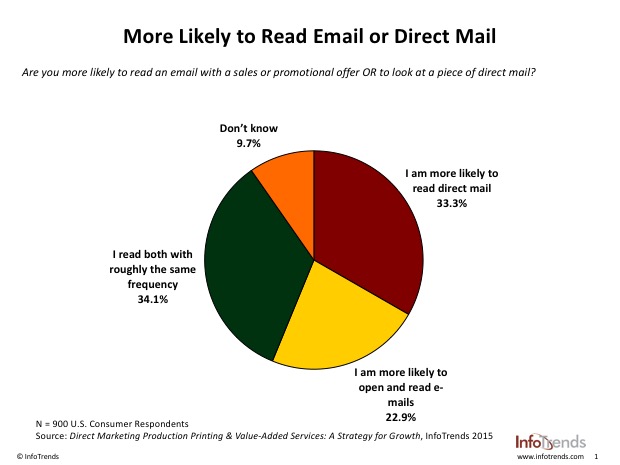For the past several years, businesses of all sizes have focused on engaging consumers with sophisticated digital marketing campaigns, but marketers are now rethinking their strategies and incorporating more direct mail in the mix. Direct mail is a very effective marketing tool because it can compel recipients to act, attract new customers, increase customer loyalty, boost brand awareness, reactivate dormant accounts, and deliver profitable results. One key reason for direct mail’s popularity is that it is able to do things more effectively than other types of marketing. Many consumers read direct mail because they prefer content that they can experience with more than just their eyes. Unlike e-mail, television, or radio ads, direct mail is a physical item that a consumer can hold in his/her hand and keep for a period of time. While some forms of marketing are fleeting and forgotten, a postcard, brochure, or catalog can serve as a lasting reminder of a marketing message.
A Critical Channel for Reaching Consumers
InfoTrends recently completed a study entitled Direct Marketing Production Printing & Value-Added Services: A Strategy for Growth. This study surveyed more than 1,800 consumers in the U.S. and Western Europe. In-depth interviews were also conducted with over 50 direct marketers and 20 print service providers. The study highlighted why direct mail is so integral to the media mix and why it needs to be a focus for print service providers in the future. This section includes key findings from our 900+ consumer respondents in the U.S. to explore why direct mail will remain a critical channel for reaching consumers.
Direct Mail Cuts through the Clutter
The ultimate objective of any marketing communication program is to get a customer or prospect to take action and preferably buy something. Direct mail works, and the statistics speak for themselves. According to InfoTrends’ survey results:
- 66% of direct mail is opened.
- 82% of direct mail is read for a minute or more.
- 56% of consumers who responded to direct mail went online or visited the physical store.
- 62% of consumers who responded to direct mail in the past three months made a purchase.
Direct Mail is the Cornerstone of a Multi-Touch Campaign
A third of U.S. consumers responding to InfoTrends’ direct marketing study reported reading direct mail more than e-mail, while 34% said they opened and read e-mail and direct mail with equal frequency.

Are you more likely to read an e-mail with a sales/promotional offer OR to look at a piece of direct mail?
Since consumers engage with both print and e-mail, communicating with them using an integrated campaign will drive higher results. In addition, direct mail can be a part of an interactive customer experience when used in conjunction with mobile devices and associated mobile apps. There are a number of tools that can enable a printed piece to trigger an interaction from a smartphone, including image recognition, augmented reality, NFC tags, and quick response codes. More and more direct marketers are integrating interactive elements with print to connect a consumer to a video or mobile-enabled website so they can learn more about a product or service, or creating mobile landing pages that enable consumers to take advantage of a coupon or discount. In addition, a direct marketer can point the consumer to a website or a personalized URL that can be accessed from a PC.
Personalization Makes a Difference
Firms of all sizes have the ability to interact with customers on a first-name basis. It has become much easier to collect, maintain, and store in-depth customer information. The technology is readily available to help marketers use this important data to communicate with customers on a personal level. Research shows that consumers are influenced by personalized communications. Of the U.S. consumers surveyed by InfoTrends, over 84% reported that personalization made them more likely to open a direct mail piece. Personalization has become a powerful direct mail tactic that is relatively easy to incorporate.

Does the customization or personalization of a direct mail piece make you more likely to open/read it?
Direct Mail Delivers Demonstrable ROI
Marketers want to be able to measure communication effectiveness so that they can improve campaigns, customer conversions, and overall return on marketing investment. Direct mail is measurable, so marketers can test offers and make the appropriate adjustments to improve results.
Recommendations for Print Service Providers
The case for leveraging direct mail in the media mix is clearly compelling. Direct mail is a tried and tested media; a staple marketing technique for companies of all shapes and sizes the world over. Given the renewed focus on direct mail as part of the media mix, service providers must ensure that they have the right technologies and skills to deliver results-oriented direct mail communications. Data and personalization are at the heart of effective direct mail communications, and marketers want to deliver relevant and personalized messaging. With all channels on, service providers must be channel-agnostic and build business models that can generate revenue from printed and digital content. As technology evolves and marketers continue to merge the print and online worlds, direct mail looks more fluid, promising, and exciting than ever.
In next week’s column, I will share insight from the in-depth interviews that InfoTrends conducted in conjunction with its Direct Marketing study. We will explore direct marketers’ and print service providers’ approaches to driving results with direct mail. For more information about InfoTrends’ study entitled Direct Marketing Production Printing & Value-Added Services: A Strategy for Growth, please contact Scott Phinney at [email protected] or 781-616-2115.















Discussion
By Patrick Whelan on Jan 14, 2016
Fantastic information. Thank you!
By Patrick Whelan on Jan 14, 2016
Service providers need to practice what they preach and position themselves as trusted providers of these services. Not nearly enough are consistently executing their own direct mail marketing initiatives to promote these services. Those that do are seeing results. I've been providing these services to printers and mailers for 21 years. I see it firsthand.
Again, great article and information.